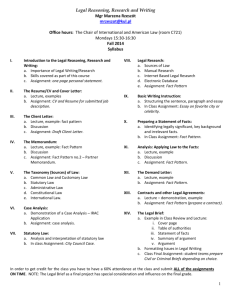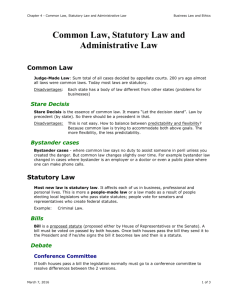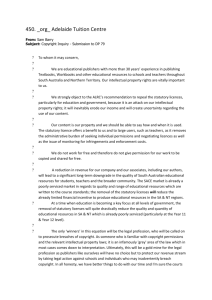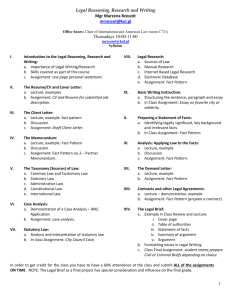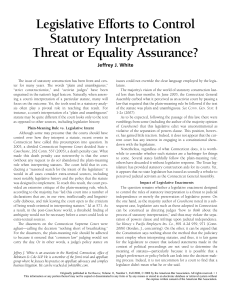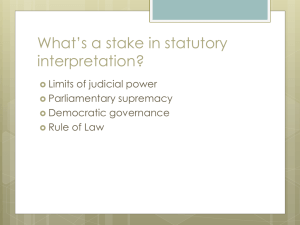Statutory Interpretation
advertisement
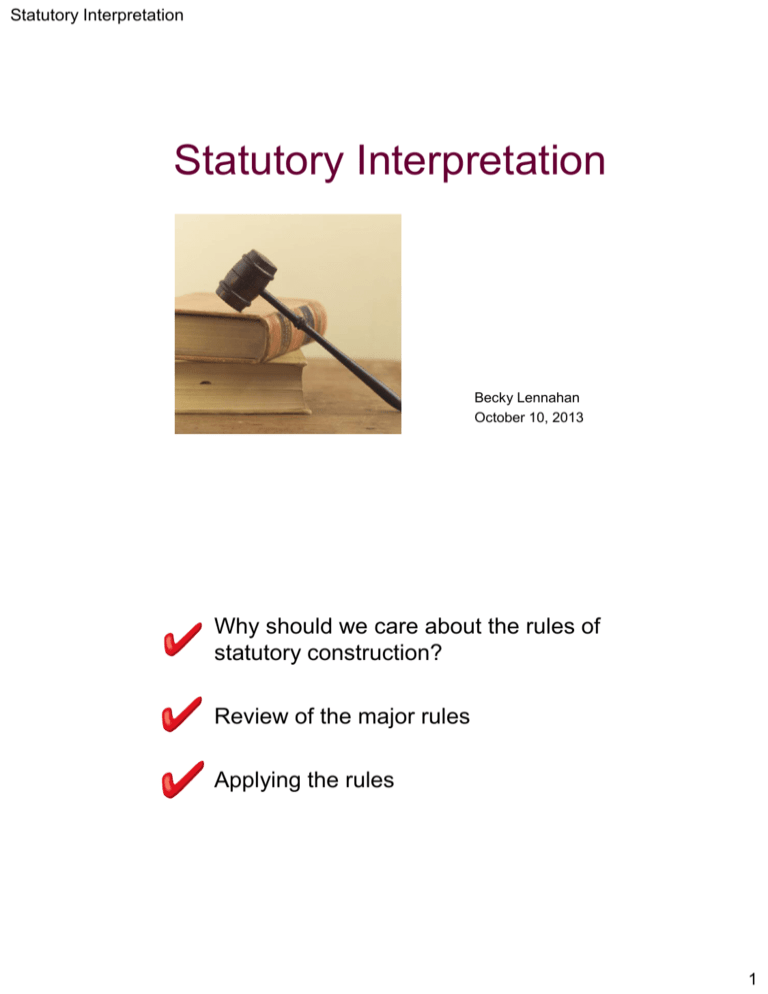
Statutory Interpretation Statutory Interpretation Becky Lennahan October 10, 2013 Why should we care about the rules of statutory construction? Review of the major rules Applying the rules 1 Statutory Interpretation Knowing what a court is likely to do helps us be better drafters. Plain language should be enough. “Where the language is plain and admits of no more than one meaning the duty of interpretation does not arise and the rules which are to aid doubtful meanings need no discussion.” Caminetti v. United States, 242 U.S.470, 37 S.Ct. 192 (1916) 2 Statutory Interpretation “Ambiguity exists when a statute is capable of being understood by reasonably wellinformed persons in two or more different senses.” - Sutherland on Statutory Construction, section 45.02 (5th ed. 1992) Lessons from the Colorado Office of Legislative Legal Services panel of judges and legislators on statutory interpretation: 1. The rules of statutory construction are alive and well, in both the judicial and legislative branches. 3 Statutory Interpretation 2. Judges believe their job is to give effect to legislative intent. 3. Judges would like the law to say what the purpose is. There are problems with the canons of statutory construction: – For every canon, there’s an equal and opposite canon. – Prof. Paul Campos, University of Colorado School of Law: There’s really only one canon: In interpreting statutes, try not to do anything really stupid. 4 Statutory Interpretation Richard A. Posner, 50 University of Chicago Law Review 800, Spring 1983: “. . . There is no evidence that members of Congress, or their assistants who do the actual drafting, know the code or that if they know, they pay attention to it. Nor, in truth, is there any evidence that they do not. . . . Probably, though, legislators do not pay attention to it, if only because . . . the code is internally inconsistent. We should demand evidence that statutory draftsmen follow the code before we erect a method of interpreting statutes on the improbable assumption that they do.” Despite the opinions from academia, the cases are replete with references to the rules of statutory construction and to the presumption that laws are drafted against a background of those rules. 5 Statutory Interpretation Where to find the rules • Court decisions • Statutes – Statute-wide definitions – State statutes on statutory interpretation – Uniform Statute and Rule Construction Act See http://www.law.upenn.edu/bll/ulc/fnact99/1990s/usrca95.htm • Sutherland Statutory Construction (a treatise) A court’s primary task in construing a statute is to give effect to legislative intent. A court may consider the statute’s history. 6 Statutory Interpretation Understand how courts apply legislative history The “belt and suspenders” approach to statutory interpretation – Writing clearly isn’t always enough – Legislative history may show that the legislature was dealing with a problem that was different from the one before the court. When the legislature amends a statute, it is presumed that a change in the law is intended. What does that imply for bills that “modernize” language? Does “change in the law” include overruling court decisions interpreting the law? If so, drafters need to be aware of court decisions. 7 Statutory Interpretation The legislature intended to comply with the federal and state constitutions. - A statute is presumed to be constitutional. - Prove unconstitutionality beyond a reasonable doubt. A statute is presumed to be prospective. 8 Statutory Interpretation • A just and reasonable result is intended. • A strained or forced construction is not favored. • Avoid inconsistent or absurd results. The entire statute is intended to be effective. Statutes addressing the same subject matter must, if possible, be construed together to give full effect to each. 9 Statutory Interpretation Statutes relating to the same subject matter should be construed in pari materia, gathering the legislative intent from the whole of the enactments. A statute is to be construed as a whole to give a consistent, harmonious, and sensible effect to all its parts. 10 Statutory Interpretation If a general provision of a statute conflicts with a specific or local provision, the specific or local provision prevails as an exception to the general provision, unless the general provision was adopted later and the manifest intent is that the general provision prevail. If statutes are irreconcilable, the statute prevails that is later in its effective date. If the irreconcilable statutes have the same effective date, the statute prevails that is latest in its passage. 11 Statutory Interpretation “Expressio unius est exclusio alterius” – The inclusion of certain items implies the exclusion of others. What about this common usage? “Defined term” means xxxxxxx and includes A, B, C, and D. Relative or qualifying words and phrases, where no contrary intention appears, are construed to refer solely to the last antecedent with which they are closely connected. 12 Statutory Interpretation Bobby is fond of dogs, cats, and rabbits that are brown. or Severability Two versions: - An objective test: After the unconstitutional portions of the statute are removed, is it possible to implement the remaining portions? - Would the legislature have intended to implement the remaining portions? 13 Statutory Interpretation Other frequently used rules: – Computation of time – The singular includes the plural – The masculine includes the feminine – Repeal of a repealing statute does not revive prior law Exercise #1 A person commits first degree burglary if the person knowingly enters unlawfully in a building or occupied structure with intent to commit therein a crime, . . . and if in effecting entry or while in the building or occupied structure or in immediate flight therefrom, . . . the person . . . is armed with . . . a deadly weapon. 14 Statutory Interpretation Before 1981 “deadly weapon” was defined as follows: “Deadly weapon” means any firearm, whether loaded or unloaded, knife, bludgeon, or other weapon, device, instrument, material, or substance, whether animate or inanimate, which in the manner it is used or intended to be used is capable of producing death or serious bodily injury. In 1980 the Supreme Court held that the “intent” clause applied only to the catch-all item at the end of the series, and that firearms, knives, and bludgeons were deadly weapons by their essential nature. 15 Statutory Interpretation In 1981 the definition was amended to read: “Deadly weapon” means any of the following which in the manner it is used or intended to be used is capable of producing death or serious bodily injury: (I) A firearm, whether loaded or unloaded; (II) A knife; (III) A bludgeon; (IV) Any other weapon, device, instrument, material, or substance, whether animate or inanimate. • In May 2005 defendant broke through the window of a home, entered and ransacked the home, took about $150 and a gun case containing two unloaded shotguns, and left. He was apprehended and charged with first degree burglary. 16 Statutory Interpretation • The prosecution argued that firearms are deadly weapons per se (intent doesn’t matter), and that if intent matters, the gun manufacturer intended that its product be capable of producing death or serious bodily injury. Exercise #2 • In 1971 the Supreme Court decreed that common law status classifications in premises liability cases (trespasser, licensee, invitee) were abolished, and landowners owed a duty of reasonable care to anyone coming on their land. In 1986 the legislature reinstated the status classifications by statute. 17 Statutory Interpretation • In 1990 the legislature specifically provided that the common law doctrine of attractive nuisance continues to apply in premises liability cases. • In 2004 the Supreme Court held that by singling out the doctrine of attractive nuisance, the legislature demonstrated its intent to abrogate all other common law doctrines related to the degree of care required of landowners. • Tort Reform: In 1975 the legislature enacted a comparative negligence approach for all tort cases. In 1986 the legislature limited defendant’s liability in all tort cases to an amount no greater than the defendant’s percentage of fault. 18 Statutory Interpretation This case: In 2002 plaintiff’s car stalled close to a railroad crossing. As a train approached, the railroad’s warning lights flashed, the automatic gates were activated, and the crossing gate arm came down on top of the car. A friend driving behind plaintiff tried to push her car over the tracks with his truck. The train struck plaintiff’s car, causing severe injuries. • Plaintiff sued defendant railroad company. Plaintiff did not join her friend. • In 2006, after the trial court barred affirmative defenses of comparative negligence and pro rata liability but before the appeal, the legislature enacted a statute to expressly permit such defenses in premises liability cases. 19 Statutory Interpretation What are the statutory interpretation issues, and how would you resolve them? 20
